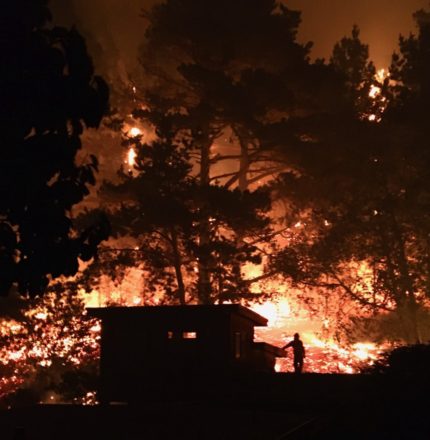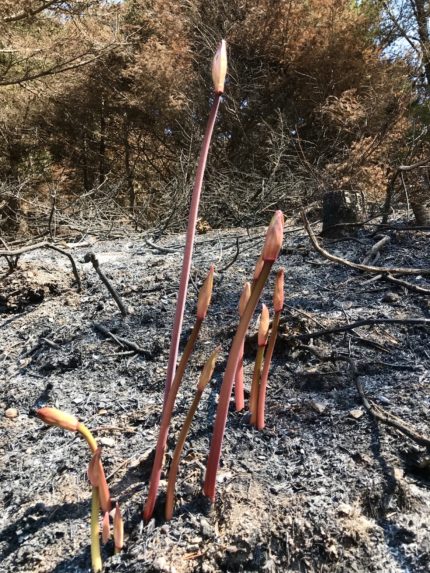
Photo by Ziad Bawarshi
The Role of Fire on the Central Coast
Fire has played a part in shaping the plant communities along California’s central coast for thousands of years. It occurred naturally, and was set intentionally by indigenous people to promote the growth of useful plants and to facilitate hunting and travel. In contrast, fire suppression became the favored management tool of government agencies throughout the 20th century. When fire burns less frequently, dry brush and dead wood build up. When it does ignite, the result is a hotter, more extensive, and damaging blaze. In recent years controlled burns have been used once again to maintain healthy ecosystems, including in Big Basin Redwoods State Park. However, some sections of the park, and many parts of the Santa Cruz Mountains, had not burned in a hundred years or more. Fuel build-up, coupled with hot, dry, weather resulted in extreme fire conditions in the summer of 2020.
The CZU Lightning Complex Fire
Lightening storms aren’t frequent occurrences in central California, but in the early morning hours of August 16, 2020 an enormous system moved through Santa Cruz county. Lightening strikes started multiple fires that destroyed over 900 homes and thousands of other structures, including all the historic buildings at Big Basin Redwoods State Park headquarters.
The Waddell Fire at Rancho del Oso, in the coastal section of Big Basin, was one of the first to ignite. It was initially a low intensity burn, clearing the Monterey pine forest of dry brush and low growing vegetation – the kind of fire plants in the area are adapted to. But further inland, hot, dry, and windy conditions caused other fires in the vicinity to merge into one fast moving conflagration. Those fires joined the Waddell Fire, threatening the Rancho del Oso Nature and History Center, State Park employee housing, and other nearby residences. Fortunately, due to increased humidity along the coast, another shift in wind direction, and the tireless efforts of State Parks staff, CalFire crews, and corrections personnel, nearly all of the buildings at Rancho del Oso were saved. The destruction of Big Basin Headquarters left Rancho del Oso with the only educational facility still standing in the park.
Post-fire Recovery

Photo by Ziad Bawarshi
Beginning in spring, 2021 botanists from California State Parks, UC Santa Cruz, and the California Native Plant Society began closely monitoring the recovery of the diverse plant communities found in Big Basin State Park. The moist environments near the coast and along Waddell Creek helped many plants survive and rebound. Chaparral plants highly adapted to fire, like manzanita, re-sprouted even before the arrival of winter rains. Bush Poppy and Monterey Pine seedlings – plants that rely on fire for germination – emerged the following spring. Most of the oldest and tallest redwoods near Big Basin headquarters survived, though many sustained serious damage. Redwoods are fire-adapted to a point, but very hot fires can take a toll. The most severe damage to native plant communities occurred in the highest, driest sections of the park where the fire burned hottest, and may take years to revegetate.
Nine months after the fire, the Rancho del Oso Nature and History Center and a small portion of the park were able to re-open. Still, much work remained to make the rest of the park safe for visitors again. Countless numbers of trees along the park’s extensive trail system did not survive the fire. Bridges, viewing platforms, and other trail structures were also destroyed. Fallen or unstable trees, and damaged trails, posed a serious hazard to anyone trying to enter the forest. By June 2021, over 3,000 trees had been felled, but the work of clearing and re-building had just begun. The Covid-19 pandemic had already dealt a crushing financial blow to local California State Parks, and the fires added another enormous setback. Luckily, financial support from donors large and small, as well as an influx of funding from the state, provided a strong start toward the recovery process.
